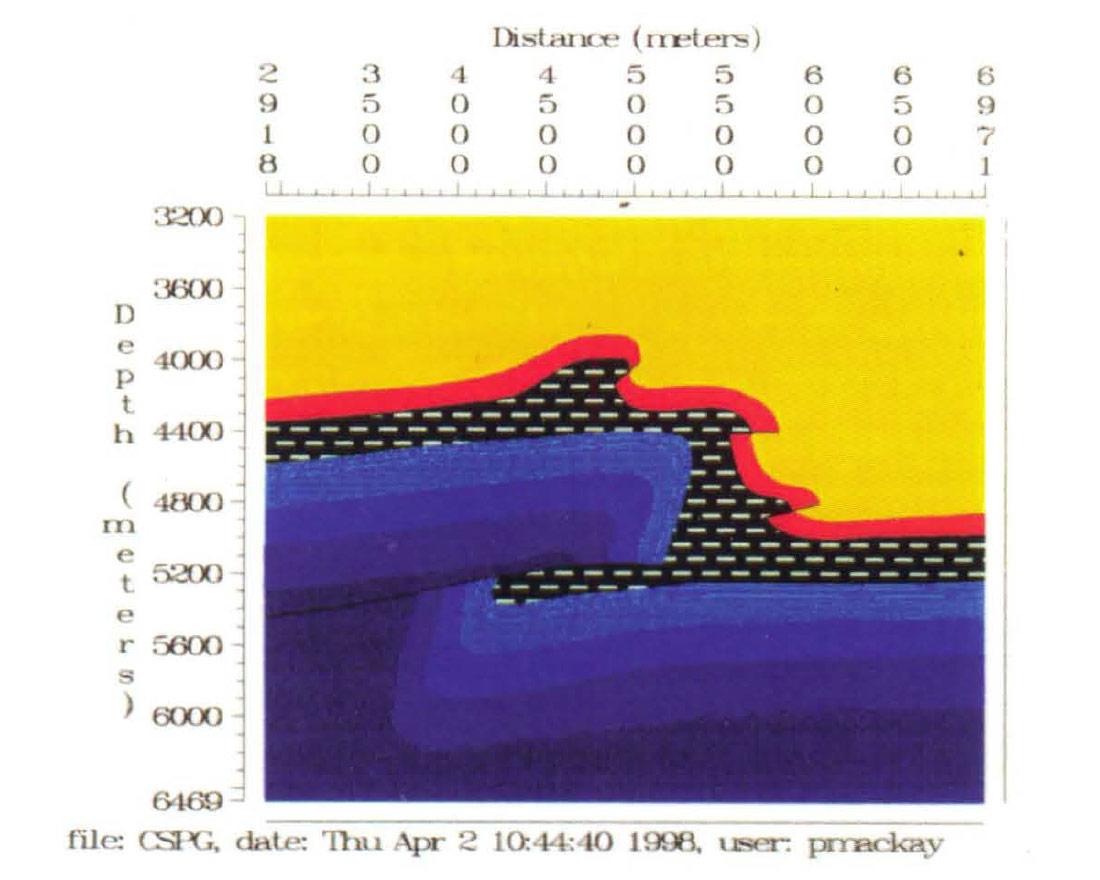The structural style of the southern Canadian Cordillera is dominated by thrust faults. Associated with the thrust faults are folds, typically a hanging wall anticline and a footwall syncline. Examples of thrust-related folds are exposed in outcrop throughout the southern Canadian Rocky Mountains. In outcrop these folds are characterized as having thinned vertical forelimbs with over-thickened hinges in the hanging wall anticline. Exposures of the footwall syncline are less common, but when observed the footwall syncline typically has near vertical thinned backlimbs with an over-thickened hinge. The cutoff angle between the thrust fault and bedding is generally large (near 90 degrees). This large cutoff angle implies that some period of folding occurred prior to thrust development and displacement. Thus the thrust fault is at a high angle to bedding but a relative low angle to the farfield, near horizontal principal compressive stress direction at the time of failure.
A model of a typical thrust related fold has been created using rock property values consistent with the Mesozoic and Paleozoic section of the southern Foothills. A synthetic seismic line shot through the model was created. The synthetic model was convolved with a 20 Hz Ricker wavelet. An interpretation of the synthetic line made independently of the knowledge of the structural style of the fold would yield an interpreted geometry that varied significantly from the model. The seismic image would lead one to the conclusion that the principal fault dipped more steeply to the left than the model. The cutoff angle between the fault and the beds appears to be less than 45 degrees on the seismic image. The vertical limbs of the fold are uninterpretable on the seismic data. In an effort to improve the seismic image from the model, shot records were generated through the model at 50 meter spacing and sent to several independent processing centres. Pre-stack depth migration was found to be the most accurate image created by the processing effort when compared to the original model. These images fail to describe the footwall syncline or the hanging wall anticline. Velocity models created through the prestack depth migration process shows the fold style although the folds are laterally shifted when compared to the original model.

The style of fold in this model is a difficult problem to deal with in the balancing and palinspastic restoration of cross-sections. Forward models of thrust belts work more effectively when the cutoff angles between the thrust fault and the beds are low (less than 30 degrees). These programs are more efficient if folding is a direct result of thrust displacement such as fault bend folds. Gas wells that successfully intersect reservoir quality rock in the hinge of the hanging wall anticline typically have the best deliverable rate of hydrocarbons. It is critical to the economic success of a well to properly position the well. With the introduction of detachment folding and recognition of the episodic nature of folding and faulting more emphasis must be placed on interpreting the data in context of the structural style. In conclusion, geological surface studies help to constrain the seismic interpretation by direct tie to the data and by providing a geometric framework to understand the limits to image resolution of the seismic data.












Join the Conversation
Interested in starting, or contributing to a conversation about an article or issue of the RECORDER? Join our CSEG LinkedIn Group.
Share This Article